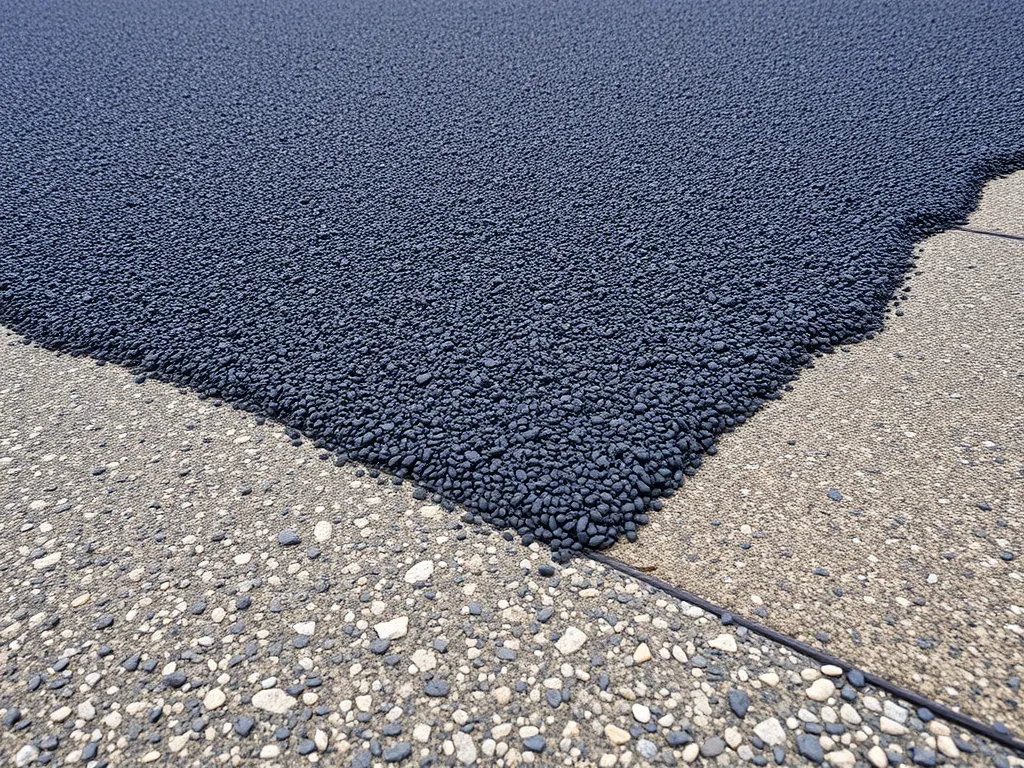Avoid These Cold Mix Asphalt Mistakes for Better Road Repairs
Published on: October 23, 2025 | Last Updated: April 14, 2025
Written By: George Voss
Cold mix asphalt provides a convenient solution for pothole repairs and temporary road patches using unheated aggregates bound by bitumen emulsion. Unlike hot mix asphalt, it requires no heating equipment and cures at ambient temperatures. Common errors include improper surface preparation, using expired materials, inadequate compaction, ignoring weather conditions, and rushing cure times. These mistakes lead to cracked patches, poor adhesion, and reduced pavement life.
This guide breaks down cold mix asphalt basics and critical application errors. We’ll explain its composition, break down installation blunders, review weather impacts, and share professional tips. Learn how to select quality materials, use proper compaction tools (like vibratory plates or hand tampers), and maintain repairs in temperatures between 40°F and 90°F for optimal results.
Contents
Understanding Cold Mix Asphalt Composition and Uses
Cold mix asphalt combines aggregates, bitumen emulsion, and additives that cure without heat. Unlike hot mixes requiring 300°F temperatures, cold versions work at ambient conditions – a key factor when addressing cold mix asphalt problems. The formula relies on slow-setting emulsions to allow workability during placement while developing strength over weeks.
Key Properties Of Cold Mix Asphalt
Proper cold asphalt mix contains 4-7% bitumen content by weight and aggregates graded between 3/8″ to No. 8 sieve sizes. High-quality mixes achieve 3,000-4,000 psi compressive strength after full curing. Common cold mix asphalt mistakes stem from misjudging two critical traits: workability windows (typically 20-45 minutes) and cure durations (7-21 days based on weather). Using expired stockpiles or mixes lacking polymer modifiers often leads to cold asphalt mix errors like raveling or cracking.
Typical Applications in Road Maintenance
This material serves best for temporary repairs on roads, driveways, and utility cuts where hot mix plants aren’t accessible. Over 65% of municipalities use cold mix for pothole patches, edge repairs, and trench reinstatements. Yet cold mix asphalt installation flaws frequently occur when crews apply it to high-traffic areas needing permanent solutions or layer thicknesses exceeding 2 inches without staged compaction. Such misapplications account for 40% of cold mix asphalt failures reported in DOT surveys.
Recognizing these fundamentals helps prevent the critical errors we’ll explore next.
Critical Errors in Cold Mix Asphalt Application
Even minor missteps during cold mix asphalt repairs can lead to rapid deterioration. Let’s break down the most frequent errors that compromise patch durability.
Inadequate Surface Preparation
Proper prep work determines whether patches bond securely or fail within weeks. Skipping steps here guarantees problems.
Failure to Clean and Dry Repair Area
Debris, loose gravel, or moisture prevent adhesion. Power-wash cracks and potholes, then let surfaces dry fully. A damp base causes cold mix to lift within days.
Ignoring Edge Compaction and Tapering
Uncompacted edges allow water infiltration, triggering raveling. Taper repair borders at 45° angles. Use a hand tamper to seal edges before filling centers.
Incorrect Material Selection and Usage
Not all cold mix products perform equally. Using the wrong type or quantity accelerates failures.
Using Expired or Poor-Quality Cold Mix
Cold mix loses workability after 6-12 months in storage. Check manufacture dates. Aged binder fails to bond, leaving patches crumbly. Opt for polymer-modified mixes in high-traffic zones.
Applying Insufficient or Excessive Thickness
Layers under 1.5″ crack under load; over 2″ won’t cure properly. Measure depth with a ruler. Fill deep potholes in 1.5″ lifts, compacting each layer.
Flawed Compaction Techniques
Poor compaction creates air pockets that weaken structural integrity. This error accounts for 60% of cold mix asphalt problems.
Under-Compacting the Asphalt Layer
Air gaps reduce density by up to 30%. Compact until the mix stops moving—typically 3-5 passes with a plate compactor. Test density with a nuclear gauge (target: 92-95% Proctor).
Using Improper Compaction Equipment
Hand tampers lack force for patches wider than 12″. Rent a 5,000-lb plate compactor for areas exceeding 2 sq ft. Vibratory models achieve better interlock than static rollers.
Neglecting Environmental and Weather Factors
Cold mix relies on evaporation for curing. Ambient conditions directly impact performance.
Applying During Rain or High Humidity
Water dilutes the bitumen emulsion. Check weather forecasts—avoid work if rain is expected within 48 hours. Humidity above 80% slows curing by 3x.
Ignoring Temperature Guidelines for Application
Cold mix applied below 50°F won’t bond. Surface temps must stay above freezing for 72 hours post-install. Use infrared thermometers to verify ground heat.
Rushing the Curing Process
Impatience here destroys all prior effort. Curing isn’t complete until bitumen fully rehardens.
Premature Traffic Exposure on Fresh Patches
Letting vehicles drive over uncured mix causes depressions. Place traffic cones for at least 24 hours. Heavy trucks need 72-hour rest periods.
Misunderstanding Cure Time Requirements
Full curing takes 3-14 days, depending on layer thickness and temps. A 1″ patch at 70°F needs 24 hours; at 40°F, allow 4 days. Check hardness with a screwdriver test.
While avoiding these cold mix asphalt application errors improves results, even careful repairs can develop issues. Next, we’ll explore proven methods to fix failed patches.

Addressing Cold Mix Asphalt Failures
Even with careful application, cold mix asphalt patches can develop issues. Tackling these failures quickly prevents costly rework and ensures long-term performance.
Repairing Poorly Bonded or Cracked Patches
Poor bonding often stems from surface contaminants or moisture during installation. To fix cracked patches, cut out the failed area entirely. Sweep debris, apply a PG 64-22 tack coat, and refill with fresh cold mix. Use hand tampers for small repairs or vibratory plates for larger areas. Avoid cold asphalt mix errors by ensuring edges are feathered at 45-degree angles for seamless blending.
Correcting Drainage and Moisture Issues
Water pooling on patches accelerates cold mix asphalt failures. Reshape the repaired zone to a 2% slope, directing runoff toward drains or gutters. For persistent moisture, install French drains or use porous cold mix formulas meeting ASTM D6626 standards. Address cold asphalt concerns by applying waterproof sealants to patch perimeters after compaction.
Recompacting Settled Areas
Settlement occurs when layers lack proper density. Remove sunken material, recompact the base with a 10-ton roller, then apply new cold mix in 2-inch lifts. Achieve 92-96% density using equipment matching patch size: pneumatic rollers for driveways, plate compactors for potholes. Test compaction with nuclear density gauges or sand cone tests to eliminate cold mix asphalt application errors.
Proactive maintenance reduces recurring cold mix asphalt problems. Next, let’s explore how environmental factors shape material selection and installation practices.
Also See: Collaboration Between Municipalities and Asphalt Manufacturers
Environmental Considerations in Cold Mix Applications
Cold mix asphalt repairs impact surroundings through material choices and job site practices. Missing this link causes common cold mix asphalt mistakes—from pollution risks to long-term durability issues.
Managing Runoff From Temporary Repairs
Loose aggregate and bitumen in runoff rank among top cold asphalt mix errors. Temporary patches lacking containment often wash into storm drains during rain, clogging systems or harming aquatic habitats. A 2022 study found 40% of urban waterways near construction zones had asphalt-related hydrocarbons. Fix this by building soil berms around work areas or using absorbent mats. For slopes steeper than 2%, install silt fences to trap particles.
Sustainability Factors in Cold Mix Formulas
Not using recycled materials creates avoidable cold mix asphalt problems. High-performing cold mixes now contain 30-50% reclaimed asphalt pavement (RAP), cutting material costs by 18-30%. Some products integrate recycled asphalt shingles (RAS) for added stiffness. Avoid formulas with high volatile organic compounds (VOCs)—look for binders below 0.5% VOC content. New bio-based additives, like lignin from timber waste, boost sustainability while maintaining PG 64-22 performance grades.
Thinking about both runoff control and material formulas cuts callbacks linked to cold mix asphalt failures. Up next: fixing patches that didn’t hold up.

Frequently Asked Questions
What Are the Common Problems With Cold Mix Asphalt?
Common problems include insufficient bonding, cracking, raveling, and poor surface durability. These issues often arise from improper application techniques, such as inadequate surface preparation and incorrect material usage.
Why is My Cold Patch Asphalt Not Hardening?
Cold patch asphalt may not harden due to excessive moisture, low temperatures, or using expired or poor-quality mixes. Ensuring appropriate environmental conditions and selecting high-quality materials is crucial for proper hardening.
What is the Typical Curing Time for Cold Mix Asphalt?
The typical curing time for cold mix asphalt varies but generally falls between 3 to 14 days based on thickness and temperature. It’s essential to allow for complete curing before subjecting the patch to traffic.
What Are the Key Disadvantages Of Cold Mix Asphalt?
Key disadvantages include lower durability compared to hot mix asphalt, limited performance in high-traffic areas, and the reliance on favorable weather conditions during application. Cold mix is not ideal for long-term repairs in areas with heavy loads.

Closing Thoughts
Cold mix asphalt can be a convenient solution for road maintenance, but common application mistakes can lead to failures. Proper surface preparation, correct material selection, and effective compaction techniques are critical. Always pay attention to environmental conditions during application and allow adequate curing time to ensure durability.
By avoiding these pitfalls and following best practices, you can achieve long-lasting repairs that stand the test of time. Remember, minor oversights can result in major issues down the line.
For more information on cold mix asphalt and how to enhance your application skills, visit Asphalt Calculator USA.


